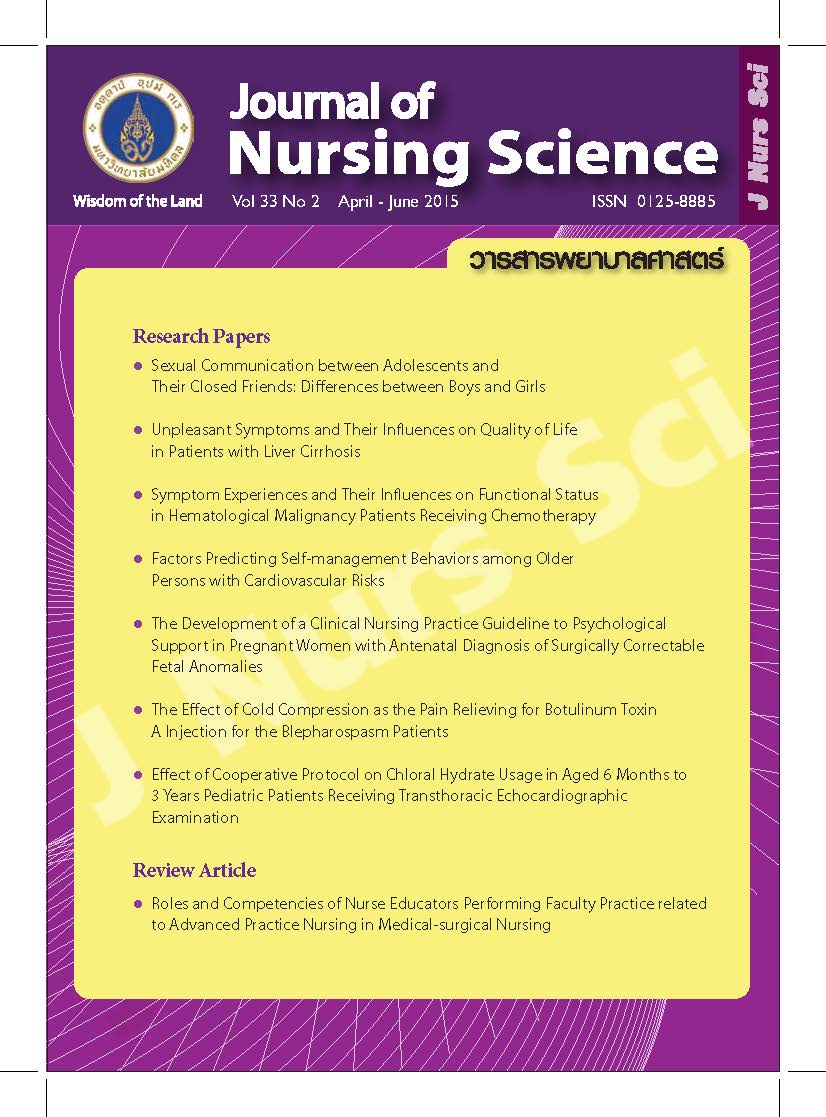Unpleasant Symptoms and Their Influences on Quality of Life in Patients with Liver Cirrhosis
Main Article Content
Abstract
Purpose: To study the perceived unpleasant symptoms, quality of life, and the predictive power of five most distress unpleasant symptoms on quality of life in patients with liver cirrhosis.
Design: Correlational predictive research.
Methods: The samples included 100 patients with liver cirrhosis who came for follow up, at outpatient liver clinic of one university hospital in Bangkok. Data were collected by using: 1) a demographic questionnaire, 2) the Memorial Symptom Assessment Scale (MSAS) developed by Portenoy and colleagues, and 3) WHOQOL-BREF-THAI. Data were analyzed by using descriptive statistics and multiple regressions.
Main findings: The results indicated that quality of life of patients with liver cirrhosis was at moderate level (mean score = 76.69, SD = 8.72). The top five most distress unpleasant symptoms reported by patients with liver cirrhosis were fatigue, followed by muscle cramps, anxiety, insomnia and lack of appetite. Among these symptoms: fatigue, anxiety, and insomnia were significant predictors that could explain 30.5% of the variance in QOL (R2 = .31, F = 8.27, p < .05). Fatigue was the strongest predictor of QOL (β = - .32) followed by Insomnia (β = - .22) and anxiety (β = - .19), respectively.
Conclusion and recommendations: Nurses should pay attention to assess and manage unpleasant symptoms in patients, particularly fatigue, anxiety, and insomnia to improve quality of life in patients with liver cirrhosis.
อาการไม่พึงประสงค์และอิทธิพลของอาการต่อคุณภาพชีวิตในผู้ป่วยโรคตับแข็ง
บทคัดย่อ
วัตถุประสงค์: เพื่อศึกษาการรับรู้อาการไม่พึงประสงค์ คุณภาพชีวิต และอิทธิพลของอาการไม่พึงประสงค์ที่รบกวนมากที่สุด 5 อันดับแรกต่อคุณภาพชีวิตของผู้ป่วยโรคตับแข็ง
รูปแบบการวิจัย: ความสัมพันธ์เชิงทำนาย
วิธีดำเนินการวิจัย: กลุ่มตัวอย่างเป็นผู้ป่วยโรคตับแข็งที่มาติดตามการรัษาที่คลินิกโรคตับ ตึกผู้ป่วยนอกของโรงพยาบาลมหาวิทยาลัยแห่งหนึ่งในกรุงเทพฯ จำนวน 100 คน เก็บข้อมูลโดยใช้แบบสอบถาม ประกอบด้วย 1) แบบบันทึกข้อมูลส่วนบุคคล 2) แบบสอบถามการมีอาการไม่พึงประสงค์ของ Portenoy และคณะ 3) แบบประเมินคุณภาพชีวิตใช้ขององค์การอนามัยโลกชุดย่อฉบับภาษาไทย วิเคราะห์ข้อมูลโดยใช้สถิติเชิงบรรยายและวิเคราะห์อำนาจการทำนายของตัวแปรที่ศึกษาโดยใช้สถิติสัมประสิทธิ์การถดถอยพหุคูณ
ผลการวิจัย: ผู้ป่วยโรคตับแข็งมีคุณภาพชีวิตโดยรวมอยู่ในระดับปานกลาง คะแนนเฉลี่ยเท่ากับ 76.69 (SD = 8.72) อาการไม่พึงประสงค์ที่ผู้ป่วยรายงานว่ารบกวนการดำเนินชีวิตประจำวันสูงที่สุด 5 อาการ ได้แก่ อาการอ่อนล้า รองลงมาได้แก่ อาการตะคริว ความกังวล/กลุ้มใจ นอนไม่หลับ/นอนหลับยาก และอาการเบื่ออาหาร ตามลำดับ ดดยมีอาการ 3 อาการ ได้แก่ อาการอ่อนล้า ความกังวลใจ/กลุ้มใจ และอาการนอนไม่หลับ/นอนหลับยาก มีอิทธิพลที่สามารถร่วมกนทำนายคุณภาพชีวิตในผู้ป่วยโรครับแข็งได้ร้อยละ 30.5 อย่างมีนัยสำคัญทางสถิติ (R2 = .31, F = 8.27, p < .05) โดยอาการอ่อนล้า มีน้ำหนักอธิบายความแปรปรวนของคุณภาพชีวิตในผู้ป่วยโรคตับแข็งได้มากที่สุด (β = - .32) รองลงมาคือ อาการนอนไม่หลับ/นอนหลับยาก (β = - .22) และความกังวล/กลุ้มใจ (β = - .189) ตามลำดับ
สรุปและข้อเสนอแนะ: พยาบาลควรให้ความสนใจต่อการประเมินอาการและจัดการกับอาการไม่พึงประสงค์ในผู้ป่วยโรคตับแข็ง โดยเฉพาะอาการอ่อนล้า นอนไม่หลับ/นอนหลับยากและความกังวล/กลุ้มใจ เพื่อเพิ่มคุณภาพชีวิตของผู้ป่วยกลุ่มนี้ต่อไป
คำสำคัญ: อาการไม่พึงประสงค์ คุณภาพชีวิต ผู้ป่วยโรคตับแข็ง
Article Details
Copyright Notice: Nursing Science Journal of Thailand has exclusive rights to publish and distribute the manuscript and all contents therein. Without the journal’s permission, the dissemination of the manuscript in another journal or online, and the reproduction of the manuscript for non-educational purpose are prohibited.

Disclaimer: The opinion expressed and figures provided in this journal, NSJT, are the sole responsibility of the authors. The editorial board bears no responsibility in this regard.

